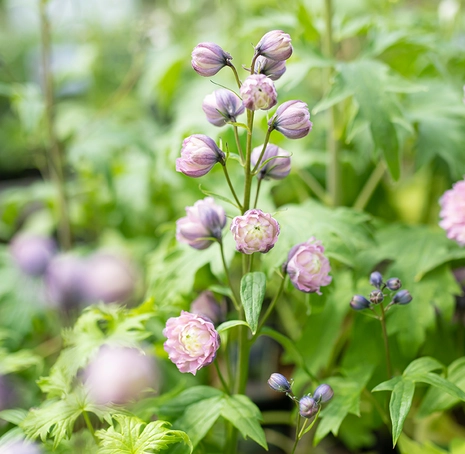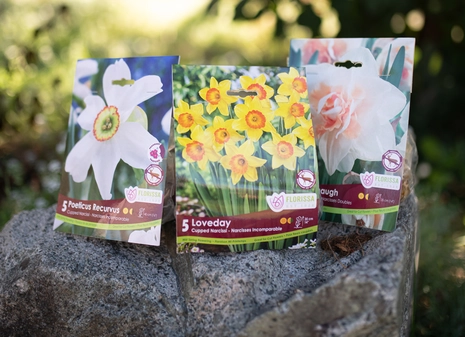Summer Blooming Bulbs
Did you know that there are two main kinds of bulbs? Spring bulbs, such as the iconic daffodil and tulip, are planted in the fall to be enjoyed in the spring. But there are also summer bulbs that are planted in the spring to be enjoyed throughout the summer. So, after the blooms of spring have faded then you can continue the show and embrace some summer bulbs.
Care of Spring-Flowering Bulbs After They Have Faded
Spring bulbs bloom from February right into May (and in a few cases into June). They have a distinct life cycle of being dormant during summer when the weather is warm. Cooler temperatures and increased water supply of fall brings the bulbs out of their dormant state. But in their summer dormancy they aren’t idle, the bulb is busy growing strong roots to help it get through its winter dormancy. When spring arrives with its warmer temperatures and longer days, the bulb “wakes up” and flowers appear, using food stored from the previous year. Then the flower fades, all that is left are leaves. This is a perfect time to feed the bulbs GARDENWORKS 3-15-8 Bulb Food, since the green leaves are hard at work making food to store for next year. As the heat of summer arrives the leaves turn yellow and the cycle begins again. Once 70% of the leaves turn yellow it’s okay to cut the leaves off at ground level. To “hide” these less-than-attractive leaves it’s a good idea to plant your summer annuals in the same spot. The care you put into your annuals will also benefit the bulbs below.
Planting Summer Blooming Bulbs
The best site for bulbs has well-drained soil with lots of organic matter. Adding a mulch or soil amendment of compost, sea soil or decomposing leaves is a great idea. Also consider adding some specially formulated GARDENWORKS Bulb Food or Bone Meal to the planting hole, to give your bulbs the best start possible. If you are planting small bulbs like cyclamen and anemones, use a trowel to dig a hole at the recommended depth (found on the back of the package). For larger bulbs, such as dahlia tubers and cannas, it is better to dig a large hole and mix the bulb food or bone meal at the bottom of the hole. Place the bulb on top of this mix, making sure that the eye (growth bud) is facing you before burying the bulb. Then water well and sit back to enjoy the show.
Click here to download a printable PDF.
A List of Summer-Blooming Favourites
Acidanthera (Gladiolus murielae)
Soil: Average
Light: Full sun to light shade
Planting Depth: 5cm (2”)
Planting Distance: 5” (15cm)
Acidanthera, also known as Abyssinian gladiolus, adds beauty and fragrance to your garden. This plant sends up creamy flowers with dark centres two months after the corms are planted. Each 60cm (2’) stem holds four or more buds that open one flower at a time. Not the hardest of bulbs it is recommended that you dig up the corms in fall and store them in vermiculite or peat. Keep them cool but not freezing in the range of 2°C to 7°C, an unheated garage or basement is perfect.
Tuberous begonias (Begonia spp.)
Soil: Rich, moist soil
Light: Part shade
Planting Depth: 5cm (2-3”)
Planting Distance: 20cm (8”)
Grown for their spectacular flowers, which can be from 5 to 20cm (2”-8”) across, that come in a variety of stunning colours. The range runs from saturated reds, corals, blush and hot pink, through yellows to white in colour. Shapes are varied, resembling a rosebud, camellia, narcissus, or carnation. To get a head start plant begonia tubers indoors in March or April. Keep them warm, at least 18°C to 20°C and in bright light. When roots develop (usually in three weeks), replant the tubers one inch below the surface of potting soil in a large pot. Transplant them outdoors after danger of frost is past. Fertilize every other week with GARDENWORKS 5-30-15 fertilizer at half strength for peak growth.
Calla lily (Zantedeschia spp.)
Soil: Neutral, moist
Light: Full sun to light shade
Planting Depth: 10cm (4”)
Planting Distance: 30-40cm (12-15”)
Callas, native to South Africa, have long leaves arising from a thick rhizome, but it is the spectacular flower that rise up out of these leaves that is to be celebrated. This is a plant that should find a home in almost every BC garden. In frost-free areas, grow callas in a moist, sunny to semi-shady location with soil an organic soil. After planting the rhizomes, water liberally and feed monthly during the growing season, with GARDENWORKS Bulb Food. After the flowers fade, reduce the amount of water. Unfortunately, only the large white calla lily (Zantedeschia aethiopica) is hardy in BC. But the smaller and brightly coloured cultivars can be treated as an annual or stored for winter. Allow the plants to dry out, then dig the rhizomes and store in dry material for the winter.
Canna lily (Canna spp.)
Soil: Neutral
Light: Full sun to light shade
Planting Depth: 10cm (4”)
Planting Distance: 20-30cm (10-12”)
If you want a bright, happy, tropical-style garden but don’t live in the tropics, plant canna lilies. The warm colours and bold foliage that cannas bring are welcome in any garden. Most cannas like a sunny position, but off-white flowering varieties can handle dappled shade. They grow well in moist soil enriched with organic matter such as compost. Fertilize in late winter with GaredenWorks Bulb Food, and be sure to water well before and after fertilizing. Keep plants mulched and water well, particularly during dry spells. Remove spent flower heads but do not cut off more than about 15cm (6”), as new flowers will be forming lower down the stem. At the end of the flowering season, cut old stems down to within 2cm (1”) of the ground. Leave new young shoots, these will flower early next season. In our climate these plants are hardy during winter but need some protection from our changeable weather. Place 2 to 5cm (¾” to 2”) of bark mulch over the top of the planting area, but remove it in spring. Lift and divide the clumps every three years.
Dahlia (Dahlia spp.)
Soil: Rich, moist soil
Light: Full sun or part shade
Planting Depth: 5-10cm (2-4”)
Planting Distance: 20-30cm (10-20”)
Dabble in dahlias if you want sure-fire colour from mid-summer to frost. Types vary from the dwarfs used for edging through larger single, anemone, peony, cactus, water lily, collarette, ball and pompon types. When planting cover the tuber with only an inch of soil, and continue to fill as the shoot grows (this encourages a healthy tuber-filled root system). Make a shallow basin around the plant to catch water and mix in some GARDENWORKS Bulb Food. Mulch to keep roots cool and the ground moist and free of weeds.
Netted iris (Iris reticulata)
Soil: Alkaline
Light: Full sun to light shade
Planting Depth: 10cm (4”)
Planting Distance: 15-20cm (6-8”)
Standing only 10 to 15cm (4” to 6”) tall, this iris is best used at the front of a mixed border or in a rock garden. The cultivar ‘Joyce’ is one to look for with its larger than most flowers. There is a range of colours available from pale to deep blue with falls (the large petals at the front that hang down) blotched with orange and even white. Related to other irises, this one is a bit different as it grows from a bulb instead of rhizomes or tubers. A hardy perennial it is good to Zone 4, but to be safe a protective mulch is always a good idea.
Lily (Lilium spp.)
Soil: Rich, well-drained
Light: Full sun
Planting Depth: 20cm (8”) exceptions are Madonna lilies at 2 to 5cm (¾” to 2”) and Turk’s-cap lilies at 5cm (2”)
When you add lilies to the summer flower garden, you add a long season of colour, dazzling blooms and in some cases fragrance. Depending on the type and variety, lilies will bloom from late spring until early fall, providing a strong backdrop in mixed borders. Growing 1m to 3m (3’ to 9’) tall, lilies have funnel or bowl-shaped flowers that may be erect, outward facing or nodding. Plant all the hardly lilies soon after they arrive, because they are never truly dormant. Add a handful of GARDENWORKS Bulb Food or Bone Meal to the bottom of each hole and a 5cm to 8cm (2” to 3”) layer of mulch over the top. Cutting individual lilies to float in bowls won’t harm next year’s bulb strength, but don’t cut long stems of too many. Lilies need thee stems and leaves to build up strength for next year’s blooms. So, try to enjoy more in the garden than you do in the vase.
Spider lily (Hymenocallis narcissiflora)
Soil: moist, well-drained
Light: Full sun to partial sun
Planting Depth: 2.5cm (1”)
Planting Distance: 30cm (1’)
A fast-growing, unusual addition to your garden. Related to daffodils and amaryllis the white flowers resemble a “spidery” version with long thin petals emerging from a central corolla. The thick strap-like green leaves are also a bold statement in the garden. Not the hardiest, it is recommended that you dig them up and store for the winter.
Gloriosa lily (Gloriosa superba ‘Rothschildiana’)
Soil: moist, well-drained
Light: Full sun to light shade
Planting Depth: 5 to 10cm (2” to 4”)
Planting Distance: 15 to 20cm (6” to 8”)
A native of east Africa and Asia this climbing vine will add an exotic touch to your garden with their scarlet and yellow coloured recurved flowers. An excellent climber this vine can grow to 1.8m (6’) so be sure to give it a trellis or some support. A great choice for container growing. Gloriosa, or flame lilies, are tropical and therefore not hardy. They must be dug up and stored for the winter.
There are, of course, many more perennial plants that are grown from bulbs and tubers at GARDENWORKS than just the ones we have listed, you’ll find shade-loving caladiums, fragrant freesias for cutting and so many more. Be sure to come in and check out the selection. Plus, our staff of garden experts are here to answer all your bulb questions, and help you choose the best ones for your garden.


